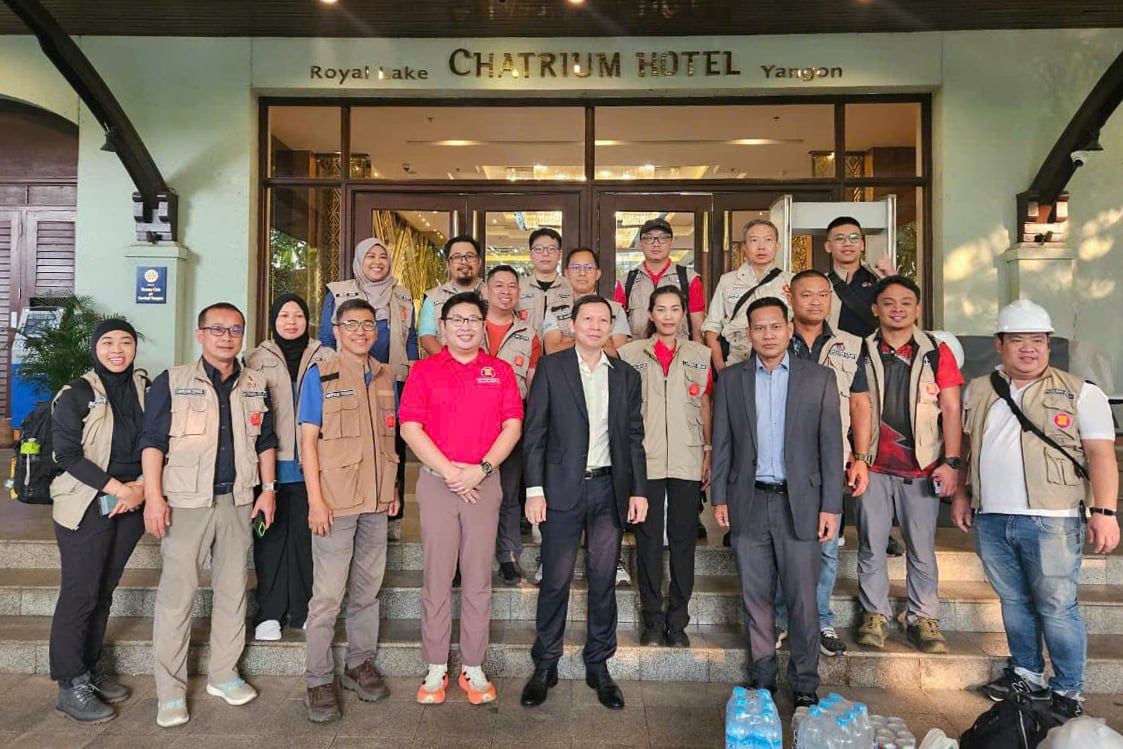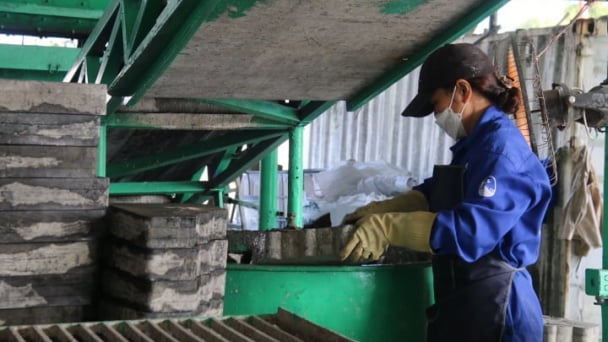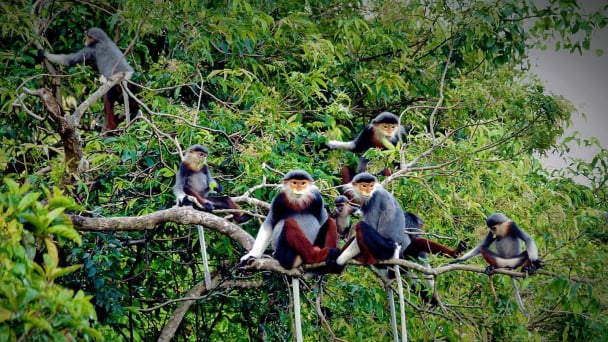May 18, 2025 | 02:33 GMT +7
May 18, 2025 | 02:33 GMT +7
Hotline: 0913.378.918
May 18, 2025 | 02:33 GMT +7
Hotline: 0913.378.918

Three officers from the Vietnam Disaster and Dyke Management Authority (VDDMA) gather in Yangon, Myanmar before moving to localities. Photo: VDDMA.
On March 31, three staff members from the Vietnam Disaster and Dyke Management Authority (VDDMA), Nguyen Minh Thai, Dang Quoc Thinh, and Nguyen Van Hoang, arrived in Myanamar from Hanoi and Danang. These Vietnamese personnel have joined the ASEAN team in the morning of April 1 and have since been deployed to various locations in Myanmar to aid the country in overcoming the repercussions of the disaster.
Nguyen Van Hoang arrived in Nay Pyi Taw, Dang Quoc Thinh is en route to Sagaing, while Nguyen Minh Thai has joined the team in Mandalay. Among these, Mandalay was the most severely struck by the earthquake that occurred in Myanmar on March 28.
Vietnam Disaster and Dyke Management Authority (VDDMA) has delegated its personnel with the responsibility of coordinating key activities, compiling information, conducting rapid assessments, and coordinating international humanitarian efforts.
Specialized agencies have reported that catastrophic impacts, such as casualties, infrastructure damages, and assets, are being reported. A state of emergency is currently declared in the six hardest-hit areas of Mandalay, Sagaing, Magway, Shan State, Naypyidaw, and Bago.
The Department of Disaster Prevention and Mitigation in Thailand has decided that the situation is severe, with significant hazards to the lives, physical health, and property of the individuals affected on a large scale, as well as considerable damages.
The magnitude 7.7 earthquake caused tremors that were felt in all 63 provinces of Thailand, with 18 provinces and Bangkok reporting significant impacts. Chiang Mai, Chiang Rai, Phayao, Lamphun, Lampang, Mae Hong Son, Phrae, Nan, Phetchabun, Phitsanulok, Sukhothai, Phra Nakhon Si Ayutthaya, Pathum Thani, Nonthaburi, Samut Prakan, Samut Sakhon, Chai Nat, and Ang Thong are among the provinces that have been impacted.
The earthquake resulted in a variety of damage, such as the destruction of residential structures, hospitals, schools, temples, and government facilities. Bangkok was the most severely affected, with the collapse of a 30-story building that was under construction in Chatuchak District.

ASEAN-ERAT members gather in Yangon before departing for their localities. Photo: VDDMA.
As a result of the earthquake's modest depth and high magnitude, aftershocks are anticipated, which may pose further risks to infrastructure, lives, and ongoing rescue operations. Emergency response efforts are anticipated to be hindered by potential fires, disrupted communication lines, and damaged buildings. The USGS's aftershock forecasts indicate a 72% likelihood of one or more aftershocks exceeding magnitude 5, which might result in further damage in the upcoming week.
Expected in the upcoming week are smaller aftershocks, with a maximum of 560 aftershocks of magnitude 3.0 or higher. The aftershocks are typically powerful enough to be felt locally, with a magnitude of 3.0 or higher. Although larger aftershocks may temporarily increase the number, the number of aftershocks will progressively decrease over time.
The risk of liquefaction and landslides along the Sagaing Fault is both high and pervasive. The primary earthquake's impact may be exacerbated by ground movement caused by these hazards. Additionally, the infrastructure in the affected regions may have already been substantially compromised in terms of its structural integrity. This could lead to additional devastation if there is any additional ground movement. Additionally, relief and emergency response efforts may be hindered by the potential for severe damage to roads, bridges, and railway systems.
Additionally, there is a risk of asbestos exposure in earthquake-affected regions, particularly in areas where older structures have collapsed or have sustained significant damage. The majority of structures in the quake zone are constructed of reinforced concrete or masonry, according to assessments. However, ancient buildings that have collapsed or sustained significant damage may contain asbestos materials.
High temperatures (24–40°C) in the affected regions may enhance the suspension of dust particles in the air, thereby increasing the risk of inhalation. The dispersion of asbestos fibers could be considerably increased by the act of cutting or moving debris without the implementation of moisture suppression or containment measures.
ASEAN member states have established the ASEAN Emergency Response and Assessment Team (ASEAN-ERAT), which has been found since 2011. After more than a decade of operation, the mechanism has demonstrated its effectiveness as a regional cooperation model for disaster management within ASEAN. In the most challenging moments of natural disasters, the solidarity and close coordination among ASEAN countries provide a firm foundation for joint response efforts.
The ASEAN-ERAT mechanism is an outstanding example of ASEAN's unwavering dedication to the timely response to disasters. It is not only an affirmation to the organization's professional deployment, but also a demonstration of its compassion, solidarity, and cooperative spirit in humanitarian assistance.
The Ministry of Agriculture and Environment has directed the Vietnam Disaster and Dyke Management Authority (VDDMA), which is the focal agency for international cooperation in disaster management, to actively participate in this mechanism.
Translated by Linh Linh

(VAN) The project contributes to enhancing the resilience of communities vulnerable to the impacts of climate change, with a primary focus on local women.

(VAN) Green materials help save energy and resources. However, after more than 10 years, Vietnam has only developed over 200 green buildings with more than 6 million square meters of floor space.

(VAN) Vietnam - Thailand Business Forum 2025: One plus one on three connects, marking a milestone in the comprehensive strategic partnership between the two nations.

(VAN) The United Nations designated 22 May as the International Day for Biodiversity 2025 with the theme 'Harmony with nature and sustainable development.'
![Multi-channel, multi-directional Vietnamese agricultural markets: [8] A national strategy is needed](https://t.ex-cdn.com/nongnghiepmoitruong.vn/608w/files/phucpm/2025/05/15/1435-thi-truong-nong-san-viet-da-kenh-da-huongbai-8-can-mot-chien-luoc-quoc-gia-084750_728.jpg)
(VAN) The Chairman of Hung Nhon Group shared: ‘Opening up and tapping into new markets is the right and strategic direction for Vietnam's agricultural sector.’

(VAN) Food waste has become a serious issue in modern society, especially in rapidly urbanizing and developing cities like Hanoi.
![Multi-channel, multi-directional Vietnamese agricultural markets: [7] Deep processing makes global reach easy](https://t.ex-cdn.com/nongnghiepmoitruong.vn/608w/files/huytd/2025/05/16/2946-che-bien-sau-chia-khoa-vang-nang-tam-nong-san-viet-tren-ban-do-the-gioi-080603_110-093858.jpg)
(VAN) The application of deep processing technology is helping Vietnamese agricultural products enhance their value, create competitive advantages, and open doors to conquer global consumers.